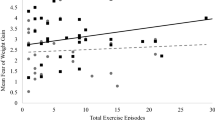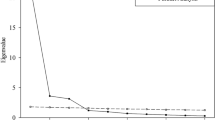Abstract
Purpose
Obligatory exercise is characterized by continued exercise despite negative consequences, and intense negative affect when unable to exercise. Research suggests psychosocial differences between individuals that exercise in an obligatory manner and those that do not. It also has been speculated that obligatory exercise may serve coping and affect regulation functions, yet these factors have not been routinely examined in community women with poor body image. The purpose of the current study was to investigate psychosocial differences between obligatory and non-obligatory exercisers, and to examine the use of obligatory exercise as an avoidant coping strategy in a sample of women with poor body image.
Methods
Women (n = 70) seeking treatment for body dissatisfaction were divided into obligatory and non-obligatory exercise groups based on their scores on the Obligatory Exercise Questionnaire. Participants then completed an assessment battery about eating pathology, body image, reasons for exercise, coping strategies, and negative affect.
Results
Independent t test analyses indicated that obligatory exercisers had significantly greater eating disorder symptomatology, avoidant coping, and appearance- and mood-related reasons for exercise than non-obligatory exercisers. Multiple regression analyses revealed that eating disorder symptomatology and avoidant coping were significant predictors of obligatory exercise.
Conclusions
There are distinct psychosocial differences between women with poor body image who exercise in an obligatory fashion and those who do not. The current study suggests that obligatory exercise may serve as an avoidant coping strategy for women with poor body image. Enhancing healthy coping strategies may be an important addition to body image improvement programs.
Level of evidence
V, cross-sectional descriptive study.
Similar content being viewed by others
References
Fallon EA, Harris BS, Johnson P (2014) Prevalence of body dissatisfaction among a United States adult sample. Eat Behav 15:151–158. https://doi.org/10.1016/j.eatbeh.2013.11.007
Kruger J, Galuska DA, Serdula MK, Jones DA (2004) Attempting to lose weight: specific practices among US adults. Am J Prev Med 26:402–406. https://doi.org/10.1016/j.amepre.2004.02.001
Penedo FJ, Dahn JR (2005) Exercise and well-being: a review of mental and physical health benefits associated with physical activity. Curr Opin Psychiatry 18:189–193. https://doi.org/10.1016/j.yco.2004.09.001
Mond JM, Hay PJ, Rodgers B, Owen C (2006) An update on the definition of “excessive exercise” in eating disorders research. Int J Eat Disord 39:147–153. https://doi.org/10.1002/eat.20214
Thome JL, Espelage DL (2007) Obligatory exercise and eating pathology in college females: Replication and development of a structural model. Eat Behav 8:334–339. https://doi.org/10.1016/j.eatbeh.2006.11.009
Davis C (1997) Body image, exercise, and eating behaviors. In: Fox K (ed) The physical self: From motivation to well-being. Human Kinetics, Champaign, pp 143–174
Peñas-Lledó E, Vaz Leal FJ, Waller G (2002) Excessive exercise in anorexia nervosa and bulimia nervosa: relation to eating characteristics and general psychopathology. Int J Eat Disord 31:370–375. https://doi.org/10.1002/eat.10042
Meyer C, Taranis L, Goodwin H, Haycraft E (2011) Compulsive exercise and eating disorders. Eur Eat Disord Rev 19:174–189. https://doi.org/10.1002/erv.1122
American Psychiatric Association (2013) Diagnostic and statistical manual of mental disorders (5th edn). American Psychiatric Publishing, Arlington
Rudolph S (2017) The connection between exercise addiction and orthorexia nervosa in German fitness sports. Eat Weight Disord. https://doi.org/10.1007/s40519-017-0437-2
Adkins EC, Keel PK (2005) Does “excessive” or “compulsive” best describe exercise as a symptom of bulimia nervosa? Int J Eat Disord 38:24–29. https://doi.org/10.1002/eat.20140
Davis C, Fox J (1993) Excessive exercise and weight preoccupation in women. Addict Behav 18:201–211
Coen SP, Ogles BM (1993) Psychological characteristics of the obligatory runner: a critical examination of the anorexia analogue hypothesis. J Sport Exerc Psychol 15:338–354. https://doi.org/10.1123/jsep.15.3.338
Steffen JJ, Brehm BJ (1999) The dimensions of obligatory exercise. Eat Disord 7:219–226. https://doi.org/10.1080/10640269908249287
Boyd C, Abraham S, Luscombe G (2007) Exercise behaviours and feelings in eating disorder and non-eating disorder groups. Eur Eat Disord Rev 15:112–118. https://doi.org/10.1002/erv.769
Mond JM, Calogero RM (2009) Excessive exercise in eating disorder patients and in healthy women. Aust N Z J Psychiatry 43:227–234. https://doi.org/10.1080/00048670802653323
Macfarlane L et al (2016) Identifying the features of an exercise addiction: a Delphi study. J Behav Addict 5:474–484. https://doi.org/10.1556/2006.5.2016.060
Mond JM, Hay PJ, Rodgers B, Owen C, Beumont PJ (2004) Relationships between exercise behaviour, eating-disordered behaviour and quality of life in a community sample of women: when is exercise ‘excessive?’ Eur Eat Disord Rev 12:265–272. https://doi.org/10.1002/erv.579
Taranis L, Meyer C (2011) Associations between specific components of compulsive exercise and eating-disordered cognitions and behaviors among young women. Int J Eat Disord 44:452–458. https://doi.org/10.1002/eat.20838
Freimuth M, Moniz S, Kim SR (2011) Clarifying exercise addiction: Differential diagnosis, co-occurring disorders, and phases of addiction. Int J Res Public Health 8:4069–4081. https://doi.org/10.3390/ijerph8104069
Smith JE, Wolfe BL, Laframboise DE (2001) Body image treatment for a community sample of obligatory and non-obligatory exercisers. Int J Eat Disord 30:375–388. https://doi.org/10.1002/eat.1099
Bratland-Sanda S, Martinsen EW, Rosenvinge JH, Rø Ø, Hoffart A, Sundgot-Borgen J (2011) Exercise dependence score in patients with longstanding eating disorders and controls: the importance of affect regulation and physical activity intensity. Eur Eat Disord Rev 19:249–255. https://doi.org/10.1002/erv.971
Lease HJ et al (2016) My mother told me: the roles of maternal messages, body image, and disordered eating in maladaptive exercise. Eat Weight Disord 21:469–476. https://doi.org/10.1007/s40519-015-0238-4
Thome J, Espelage DL (2004) Relations among exercise, coping, disordered eating, and psychological health among college students. Eat Behav 5:337–351. https://doi.org/10.1016/j.eatbeh.2004.04.002
De Young KP, Anderson DA (2010) Prevalence and correlates of exercise motivated by negative affect. Int J Eat Disord 43:50–58. https://doi.org/10.1002/eat.20656
Compas BE, Jaser SS, Dunbar JP, Watson KH, Bettis AH, Gruhn MA, Williams EK (2014) Coping and emotion regulation from childhood to early adulthood: points of convergence and divergence. Aust J Psychol 66:71–81. https://doi.org/10.1111/ajpy.12043
Zalewski M, Lengua LJ, Wilson AC, Trancik A, Bazinet A (2011) Associations of coping and appraisal styles with emotion regulation during preadolescence. J Exp Child Psychol 110:141–158. https://doi.org/10.1016/j.jecp.2011.03.001
Fairburn CG, Cooper Z, Shafran R (2003) Cognitive behavior therapy for eating disorders: a “transdiagnostic” theory and treatment. Behav Res Ther 41:509–528. https://doi.org/10.1016/S0005-7967(02)00088-8
Lawson R, Waller G, Lockwood R (2007) Cognitive content and process in eating disordered patients with obsessive-compulsive features. Eat Behav 8:305–310. https://doi.org/10.1016/j.eatbeh.2006.11.006
Stice E (2001) A prospective test of the dual-pathway model of bulimic pathology: mediating effects of dieting and negative affect. J Abnorm Psychol 110:124–135. https://doi.org/10.1037/0021-843X.110.1.124
Metropolitan Life Insurance Company (1983). 1983 height and weight tables. Stat Bull Metrop Life Found 6:3–9
Brown T, Cash T, Mikulka P (1990) Attitudinal body-image assessment: Factor analysis of the Body-Self Relations Questionnaire. J Pers Assess 55:889–897. https://doi.org/10.1080/00223891.1990.9674053
Cash TF (1994) Users’ manual for the Multidimensional Body-Self Relations Questionnaire. Old Dominion University, Norfolk
First MB, Spitzer RL, Gizzon M, Williams JBW (2002) Structured clinical interview for DSM-IV-RT axis I disorders. Biometrics Research, New York
Pasman, L, Thompson JK (1998) Body image and eating disturbance in obligatory runners, obligatory weightlifters, and sedentary individuals. Int J Eat Disord 7:759–769. https://doi.org/10.1002/1098-108X(198811)7:6<759::AID-EAT2260070605>3.0.CO;2-G
Cooper PJ, Taylor MJ, Cooper Z, Fairburn CG (1987) The development and validation of the body shape questionnaire. Int J Eat Disord 6:485–494. https://doi.org/10.1002/1098-108X(198707)6:4<485::AID-EAT2260060405>3.0.CO;2-O
Garner DM, Garfinkel PE (1979) The Eating Attitudes Test: An index of the symptoms of anorexia nervosa. Psychol Med 9:273–279. https://doi.org/10.1017/S0033291700030762
Endler NS, Parker JDA (1999) Coping inventory for stressful situations (CISS) manual, 2nd edn. Multi-Health Systems, Toronto
Silberstein LR, Striegel-Moore RH, Timko C, Rodin J (1988) Behavioral and psychological implications of body dissatisfaction: do men and women differ? Sex Roles 19:219–232. https://doi.org/10.1007/BF00290156
Beck AT, Steer RA, Brown GK (1996) Beck depression inventory-II. Psychological Corporation, Texas
Spielberger C (1983) Manual for the state-trait anxiety inventory. Consulting Psychologists Press, California
Cash T (2008) The body image workbook: an eight-step program for learning to like your looks. New Harbinger Publications, California
IBM Corp (2016) IBM SPSS Statistics for Windows, Version 24.0. IBM, New York
Verhoef MJ, Love EJ (1994) Women and exercise participation: the mixed blessing of motherhood. Health Care Women Int 15:297–306. https://doi.org/10.1080/07399339409516122
Garner DM, Olmsted MP, Bohr Y, Garfinkel PE (1982) The Eating Attitudes Test: psychometric features and clinical correlates. Psychol Med 12:871–878. https://doi.org/10.1017/S0033291700049163
Shroff H, Reba L, Thornton LM, Tozzi F, Klump KL, Berrettini WH et al (2006) Features associated with excessive exercise in women with eating disorders. Int J Eat Disord 39:454–461. https://doi.org/10.1002/eat.20247
Borkovec TD (2002) Life in the future versus life in the present. Clin Psychol Sci Pract 9:78–80. https://doi.org/10.1093/clipsy.9.1.76
Roemer L, Orsillo SM (2002) Expanding our conceptualization of and treatment for generalized anxiety disorder: integrating mindfulness/acceptance-based approaches with existing cognitive behavioral models. Clin Psychol Sci Pract 9:54–68. https://doi.org/10.1093/clipsy.9.1.54
Loumidis K, Wells A (2001) Exercising for the wrong reasons: relationships among eating disorder beliefs, dysfunctional exercise beliefs and coping. Clin Psychol Psychother 8:416–423. https://doi.org/10.1002/cpp.298
Sherwood NE, Crowther JH, Wills L, Ben-Porath YS (2000) The perceived function of eating for bulimic, subclinical bulimic, and non-eating disordered women. Behav Ther 31:777–793. https://doi.org/10.1016/S0005-7894(00)80044-1
VanBoven AM, Espelage DL (2006) Depressive symptoms, coping strategies, and disordered eating among college women. J Couns Dev 84:341–348. https://doi.org/10.1002/j.1556-6678.2006.tb00413.x
Belon KE, McLaughlin EA, Smith JE, Bryan AD, Witkiewitz K, Lash DN, Winn JL (2015) Testing the measurement invariance of the Eating Disorder Inventory in non-clinical samples of Hispanic and Caucasian women. Int J Eat Disord 48:262–270. https://doi.org/10.1002/eat.22286
Belon KE, Smith JE, Bryan AD, Lash DN, Winn JL, Gianini LM (2011) Measurement invariance of the Eating Attitudes Test-26 in Caucasian and Hispanic women. Eat Behav 12:317–320. https://doi.org/10.1016/j.eatbeh.2011.07.007
Funding
This study was not supported by funding.
Author information
Authors and Affiliations
Corresponding author
Ethics declarations
Conflict of interest
The authors declare that they have no conflict of interest.
Ethical approval
All procedures performed in this study involving human participants were in accordance with the ethical standards of the institutional and/or national research committee and with the 1964 Helsinki declaration and its later amendments or comparable ethical standards.
Informed consent
Informed consent was obtained from all individual participants included in this study.
Rights and permissions
About this article
Cite this article
Serier, K.N., Smith, J.E., Lash, D.N. et al. Obligatory exercise and coping in treatment-seeking women with poor body image. Eat Weight Disord 23, 331–338 (2018). https://doi.org/10.1007/s40519-018-0504-3
Received:
Accepted:
Published:
Issue Date:
DOI: https://doi.org/10.1007/s40519-018-0504-3




